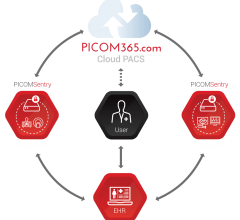If you enjoy this content, please share it with a colleague
RELATED CONTENT
March 30, 2021 — ScImage, Inc. celebrates its cloud partnership with Digirad Health (“Digirad”), a division of Star ...
March 31, 2016 — Medical diagnostic imaging provider Digirad Corp. posted an article to their website discussing updates ...
The Global Nuclear Medicine Diagnostics Market report from Mordor Intelligence revealed that North America accounts for the highest share of the global nuclear medicine diagnostic market, followed by Europe and Asia-Pacific. Asian countries are expected to show a growing trend in the diagnostic sector because of increasing diagnostic procedure demand and the rise of the medical device industry.
Nuclear myocardial perfusion imaging (MPI) with positron emission tomography (PET) and single-photon emission computed tomography (SPECT) have been the gold standard for noninvasive detection of coronary ischemia and infarcts. However, the high radiation doses patients receive are making some providers think twice before referring their patients for nuclear MPI.
Public concern over radiation risks from medical imaging have been brought to the forefront with numerous mainstream media articles in recent years. Newer dose lowering technologies have helped reduce radiation dose by more than 50 percent for cardiac computed tomography angiography (CTA) scans, making it much more attractive as a diagnostic imaging modality. New CT technology — including perfusion imaging with advanced visualization software and CT-fractional flow reserve (FFR) imaging, recently cleared by the U.S. Food and Drug Administration (FDA) — may lead to increased use of CT.
When 64-slice scanners were first introduced nearly 10 years ago, CTA dose was 20-30 mSv, but new reconstruction software, more sensitive detectors and other technologies have reduced this below 10 mSv. With the newest scanners and software, it is now possible to perform CTA with about 1 mSv of dose. This new dose profile has made CTA much more attractive, and nuclear imaging now finds itself in the position as the high radiation dose technology being called into question.
Digirad Corporation announced the launch of their Molecular Breast Imaging Accessory for the ergo imaging system, further expanding the clinical flexibility of the ergo imaging system for applications in the area of women’s health, as well as in nuclear medicine where the ergo imaging system is currently used for a wide variety of clinical applications.
Single photon emission computed tomography (SPECT) remains a well-entrenched imaging modality for nuclear myocardial perfusion imaging (MPI) more than 30 years after its introduction. Due to SPECT’s reliability, cost-effectiveness and the wealth of data showing its clinical validation, it remains more common in MPI than its competition, positron emission tomography (PET).
June 7, 2011 - Digirad and Dilon Diagnostics announced that Digirad has contributed advanced photodetector technology for use in Dilon’s newest gamma camera, the U.S. Food and Drug Administration(FDA)-cleared Dilon 6800 Acella, via a technology development and OEM agreement. The new camera, which is being debuted at the 2011 Society of Nuclear Medicine Meeting in San Antonio, Texas, features the largest molecular breast imaging platform on the market, making Dilon the first company in the industry to offer customers a choice in detector sizes.
April 27, 2010 – The U.S. Food and Drug Administration (FDA) this week cleared a large field-of-view, general-purpose portable nuclear imaging system.
April 26, 2010 - The introduction of a large field, solid-state portable general-purpose camera makes it possible to image with greater flexability a wide range of nuclear medicine procedures.
The U.S. Food and Drug Administration (FDA) gave Digirad Corp. 510(k) clearance to market and distribute Ergo, a large field-of-view, general-purpose portable imaging system.
June 12, 2009 - Digirad Corp., a provider of medical diagnostic imaging products and personnel and equipment leasing services, will debut at SNM its c?pax image management and multimodality viewing system.


 March 30, 2021
March 30, 2021 





